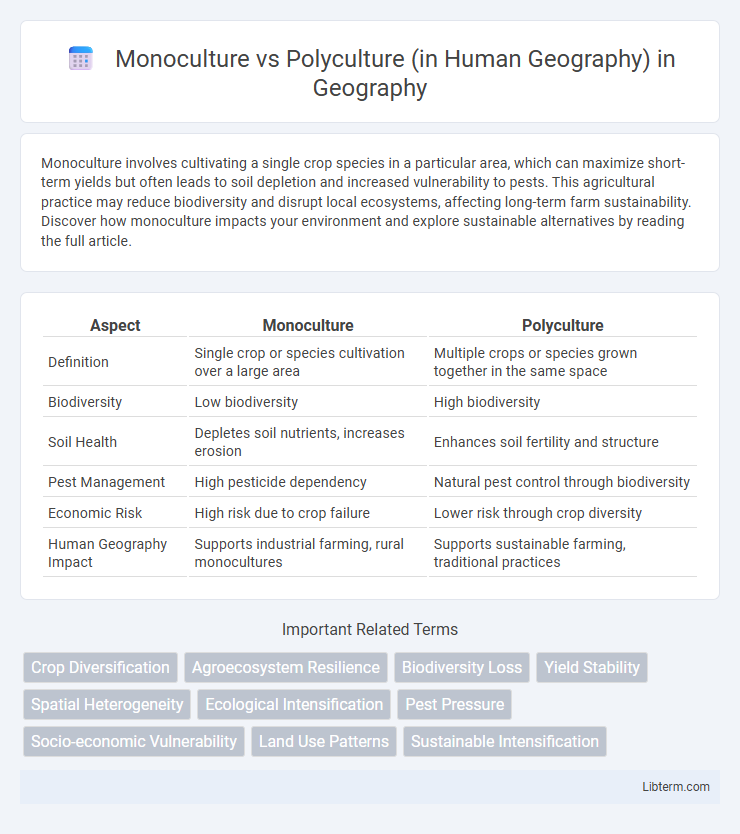Monoculture involves cultivating a single crop species in a particular area, which can maximize short-term yields but often leads to soil depletion and increased vulnerability to pests. This agricultural practice may reduce biodiversity and disrupt local ecosystems, affecting long-term farm sustainability. Discover how monoculture impacts your environment and explore sustainable alternatives by reading the full article.
Table of Comparison
| Aspect | Monoculture | Polyculture |
|---|---|---|
| Definition | Single crop or species cultivation over a large area | Multiple crops or species grown together in the same space |
| Biodiversity | Low biodiversity | High biodiversity |
| Soil Health | Depletes soil nutrients, increases erosion | Enhances soil fertility and structure |
| Pest Management | High pesticide dependency | Natural pest control through biodiversity |
| Economic Risk | High risk due to crop failure | Lower risk through crop diversity |
| Human Geography Impact | Supports industrial farming, rural monocultures | Supports sustainable farming, traditional practices |
Introduction to Monoculture and Polyculture in Human Geography
Monoculture in human geography refers to the agricultural practice of cultivating a single crop species over a large area, which can lead to reduced biodiversity and increased vulnerability to pests and diseases. Polyculture involves growing multiple crop species in the same space, enhancing ecosystem resilience, soil health, and sustainable land use. Understanding these practices is crucial for analyzing the environmental, economic, and social impacts of agricultural systems within different geographic regions.
Historical Evolution of Agricultural Systems
The historical evolution of agricultural systems reveals a shift from diverse polyculture practices to extensive monoculture farming, driven by technological advancements and market demands. Early human societies relied on polyculture for sustainability and soil fertility, cultivating multiple crops simultaneously to reduce pest incidence and increase food security. The industrial revolution introduced mechanization and chemical inputs, enabling large-scale monoculture dominance that optimized yield but often degraded ecosystems and biodiversity.
Defining Monoculture: Characteristics and Examples
Monoculture in human geography refers to the agricultural practice of cultivating a single crop or raising a single livestock species over a wide area, often leading to simplified landscapes and economic dependence on one product. Key characteristics include uniformity of crops, reliance on synthetic inputs like fertilizers and pesticides, and vulnerability to pests, diseases, and market fluctuations. Common examples of monoculture farming include vast wheat fields in the Great Plains of the United States and extensive oil palm plantations in Southeast Asia.
Understanding Polyculture: Benefits and Practices
Polyculture in human geography involves cultivating multiple crop species in the same space, enhancing biodiversity and ecosystem stability. This practice improves soil health, reduces pest outbreaks, and increases resilience to climate variability by mimicking natural ecosystems. Farmers employing polyculture techniques often experience higher yields and sustainable land use compared to monoculture systems dominated by a single crop.
Economic Impacts of Monoculture vs Polyculture
Monoculture agriculture often generates higher short-term economic returns by specializing in a single high-demand crop, but it risks soil degradation and market vulnerability due to lack of diversification. Polyculture systems enhance economic stability through diversified production, reducing dependency on a single crop and improving resilience against pests, diseases, and price fluctuations. Long-term economic sustainability favors polyculture by promoting soil health and ecosystem services that support consistent agricultural productivity.
Environmental Consequences and Sustainability
Monoculture farming significantly increases vulnerability to pests and diseases, leading to higher pesticide use and soil degradation, which undermines long-term sustainability. Polyculture enhances biodiversity, improves soil health through diverse root systems, and reduces the need for chemical inputs, promoting ecological balance and resilience. Sustainable agricultural practices prioritize polyculture to mitigate environmental consequences such as nutrient depletion, erosion, and biodiversity loss.
Social and Cultural Dimensions in Farming Systems
Monoculture farming concentrates on cultivating a single crop species, often leading to reduced cultural diversity and increased vulnerability to social disruptions within rural communities. In contrast, polyculture systems promote agricultural biodiversity, supporting traditional knowledge, cultural practices, and social cohesion by maintaining diverse crop varieties and interdependent farming activities. These differing approaches influence food security, community resilience, and the preservation of indigenous agricultural heritage.
Case Studies: Global Perspectives on Crop Selection
Monoculture systems dominate regions such as the Midwestern United States, where vast fields of single crops like corn maximize mechanized efficiency but increase vulnerability to pests and soil degradation. In contrast, numerous sub-Saharan African communities practice polyculture, integrating diverse crops such as millet, beans, and sorghum to enhance food security, preserve soil fertility, and adapt to variable climate conditions. Case studies from Southeast Asia highlight the benefits of rice-fish farming, a polyculture method that improves yield diversity and reduces reliance on chemical inputs, underscoring how crop selection aligns with ecological sustainability and local livelihoods worldwide.
Challenges and Opportunities in Transitioning Practices
Transitioning from monoculture to polyculture in human geography faces challenges such as soil nutrient depletion, pest management, and economic risks tied to market reliance on single crops. Opportunities include enhanced biodiversity, improved ecosystem resilience, and diversified income sources, which collectively promote sustainable land use and food security. Adopting polyculture practices requires addressing knowledge gaps, initial investment costs, and developing supportive agricultural policies to facilitate effective implementation.
Future Trends and Innovations in Agricultural Geography
Emerging trends in agricultural geography highlight a shift from monoculture systems towards polyculture practices driven by sustainability and biodiversity goals. Polyculture integrates multiple crop species to enhance soil health, reduce pest outbreaks, and improve resilience to climate change, reflecting innovative agroecological approaches. Advanced technologies such as precision agriculture, AI-driven crop monitoring, and genetic diversification accelerate the adoption of diversified farming systems to meet future food security challenges.
Monoculture Infographic

 libterm.com
libterm.com